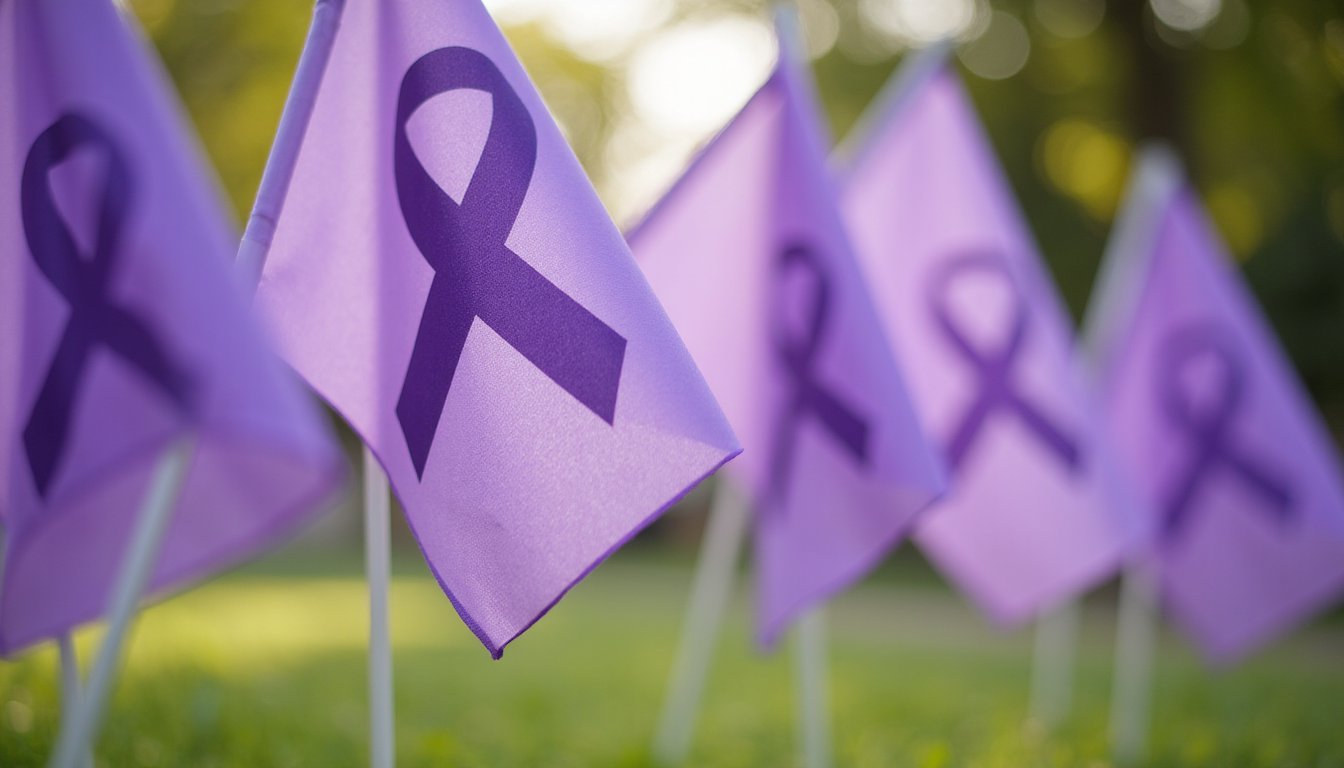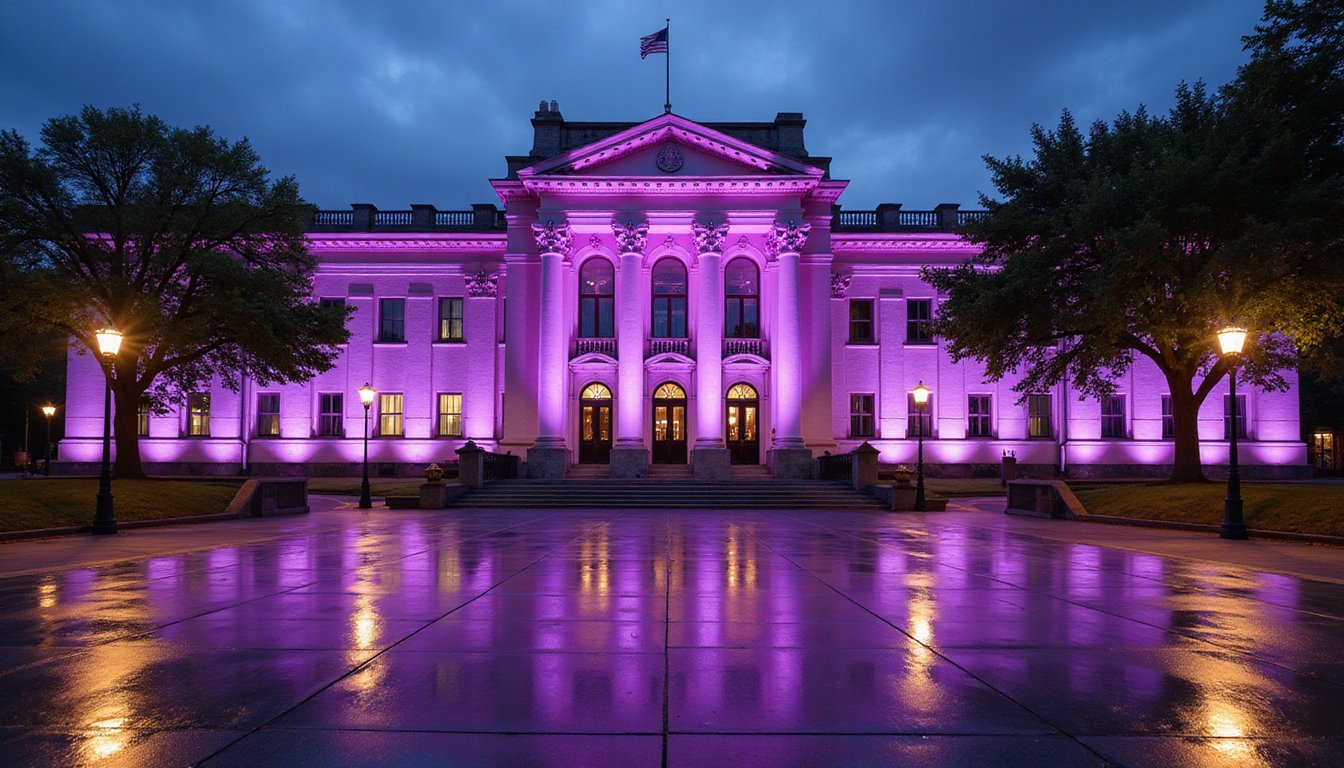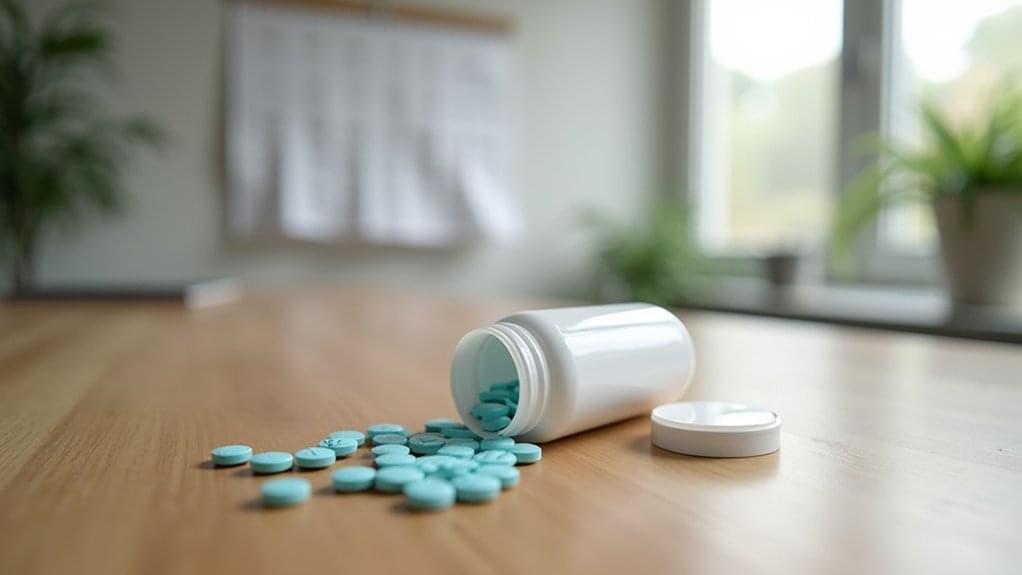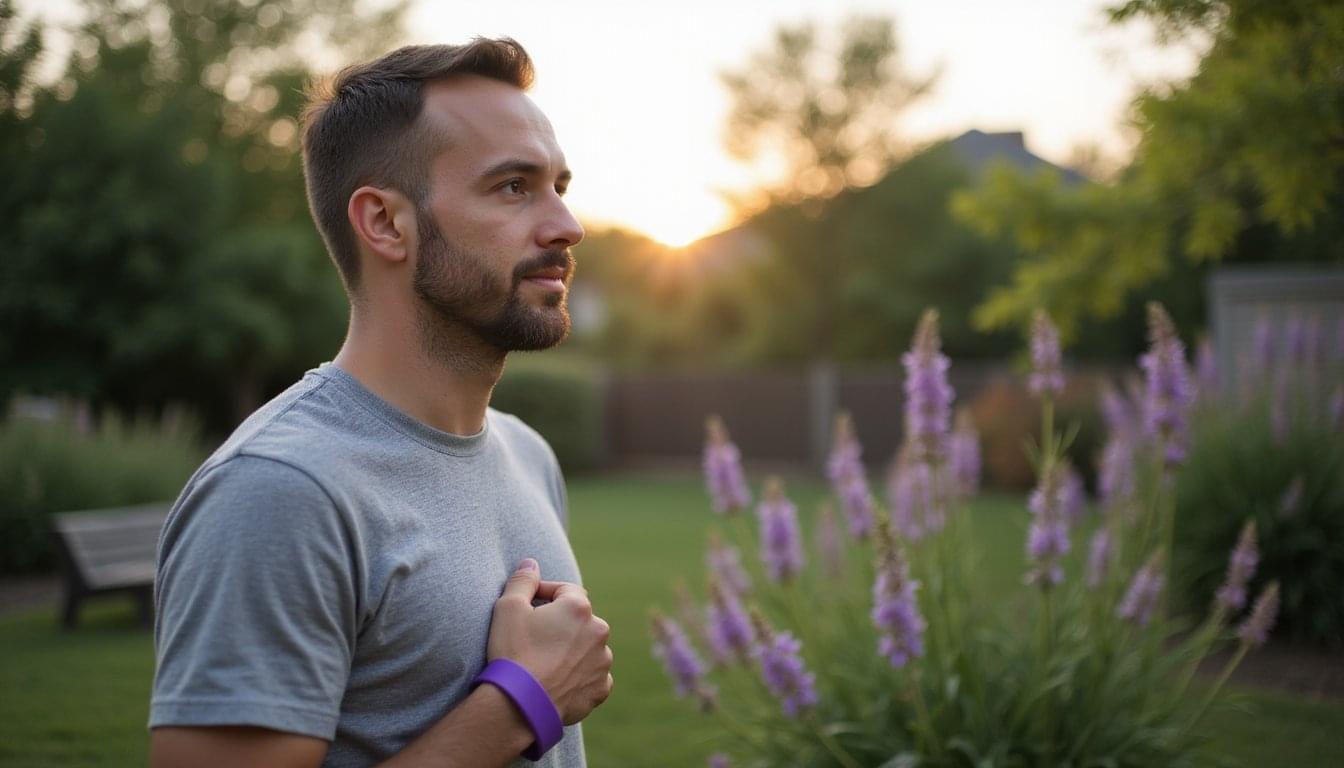Purple officially symbolizes addiction recovery, designated by SAMHSA in 1989 to represent hope, healing, and transformation. You’ll see this meaningful color at recovery events worldwide, where it creates immediate recognition and reduces stigma around addiction discussions. Research shows purple-themed campaigns have contributed to measurable improvements, including decreased overdose rates and expanded recovery services in participating communities. The consistent visual identity helps normalize recovery conversations and builds global solidarity among those on their healing journeys, making the color choice profoundly impactful for advocacy efforts.
The Origins and Meaning Behind Purple as Recovery’s Universal Color

When you see purple ribbons, lights, or social media campaigns during recovery events, you’re witnessing a powerful symbol that emerged from a deliberate effort to transform how society views addiction recovery. In 1989, SAMHSA officially designated purple as addiction recovery’s color during National Recovery Month, choosing it for its associations with hope, healing, transformation, and wisdom. You’ll find this wasn’t arbitrary; purple historically symbolizes dignity and resilience, qualities essential to recovery journeys.
The movement expanded through grassroots adoptions worldwide, creating restorative healing opportunities for communities to unite around shared experiences. Today’s #GoPurple campaigns reflect purple’s ability to foster open dialogue while reducing stigma. When you encounter purple displays, you’re seeing a visual representation of global solidarity that transforms shame into empowerment. These purple displays during recovery events unite a global community in support of those on their healing journey.
Purple ribbons also serve as tributes on International Overdose Awareness Day, honoring those lost to addiction-related causes while supporting survivors in their recovery journey. The COVID-19 pandemic has significantly challenged these recovery efforts, as social distancing measures have increased risks of relapses and overdoses among those in recovery.
How Purple Compares to Other Addiction Awareness Colors
While purple stands as addiction recovery’s official color, you’ll encounter several other hues that play important roles in addiction awareness campaigns. Turquoise emphasizes wisdom and mental health advocacy, though it’s shared with bone tumor awareness. Black honors grief and trauma associated with addiction losses, while silver represents hope and healing throughout recovery journeys. Blue supports broader health discussions but lacks exclusive association with addiction. Red ribbons specifically represent awareness of substance abuse, adding another distinct layer to addiction advocacy efforts.
These complementary color combinations create more inclusive messaging that reaches diverse audiences. You’ll notice organizations increasingly pair purple with turquoise to amplify education and community identity. This multi-color approach reflects evolving public awareness strategies, addressing specific recovery facets while maintaining purple’s central role. The expanded color spectrum demonstrates how addiction awareness has grown beyond single symbols to embrace recovery’s multifaceted nature. Additionally, teal ribbons serve dual purposes in supporting both PTSD awareness and anxiety awareness, conditions frequently linked to substance abuse disorders. SAMHSA established this official purple designation in 1989 to create unified recognition for recovery advocacy efforts.
Measurable Results From Purple-Themed Recovery Campaigns

Beyond theoretical symbolism, purple-themed recovery campaigns have generated concrete, measurable outcomes that demonstrate their real-world impact. You’ll find compelling evidence in communities that’ve embraced these initiatives, with results spanning participation rates, health statistics, and social change.
Key measurable outcomes include:
- Community engagement surges – Events like “Kent Goes Purple” consistently draw hundreds to thousands of participants, creating visible recovery networks
- Statistical improvements – San Diego County documented a 21% decrease in fatal overdose rates following purple memorial campaigns
- Service expansion – Purple campaigns correlate with expanding service capacity and enhanced resource distribution in participating regions
These campaigns also drive collaborative data tracking improvements, as communities report better cooperation with agencies. You’re seeing measurable stigma reduction through increased help-seeking behaviors and stronger policy support for recovery initiatives. Communities are allocating supplementary funding specifically for mental health services as direct outcomes of these purple awareness movements. The symbolic power becomes tangible when 945 purple flags flew to represent each person who died from overdose, creating visual memorials that honor victims while promoting prevention resources. Kent County achieved zero overdose fatalities in 2024, demonstrating how comprehensive purple-themed prevention initiatives can produce life-saving results.
Breaking Down Stigma Through Consistent Visual Identity
One powerful force drives stigma reduction in addiction recovery: the consistent use of purple as a unifying visual identity. When you see purple ribbons, illuminated landmarks, and community displays, you’re witnessing a deliberate strategy that transforms public perception. This visual consistency creates immediate recognition, making recovery conversations more accessible and less threatening.
Strategic collaborations between advocacy groups have standardized purple across platforms, while public private partnerships enable businesses and civic organizations to display supportive messaging through purple signage. You’ll notice how this repetition normalizes recovery discussions, gradually shifting community attitudes from judgment to empathy. Organizations like Hudson Behavioral Health, which has maintained its commitment to recovery services since 1980, continue to support these purple-themed awareness campaigns and community events. Purple-themed content on social media also plays a crucial role in reducing mental health stigma by reaching broader audiences online.
The “Go Purple” movement demonstrates purple’s power as a bridge across different groups, reducing the “us vs. them” mentality and fostering collective support for recovery efforts. This color choice carries deep meaning as purple traditionally represents mourning and spirituality, connecting the recovery community to broader cultural understanding of loss and healing.
Community Unity and Public Engagement Through Purple Symbolism

When you see purple ribbons, lights, and decorations throughout your community during recovery awareness campaigns, you’re witnessing a powerful symbol that brings together families, healthcare professionals, advocacy groups, and civic leaders under one unified cause. These visible displays of purple create immediate recognition and connection among diverse community members who share the common goal of supporting addiction recovery and reducing stigma. You’ll notice that landmark buildings, stadiums, and public spaces illuminated in purple don’t just raise awareness; they amplify the reach of recovery messages far beyond individual organizations to create a community-wide movement of hope and solidarity.
Purple Unites Diverse Groups
Purple’s unique ability to unite diverse groups stems from its visual power to create shared identity across different recovery communities, mental health initiatives, and support networks. Community organizations have discovered that adopting purple as their unifying color fosters remarkable group cohesion, reducing isolation among members who might otherwise feel disconnected from traditional support systems.
You’ll find purple bridging cultural and socioeconomic divides in recovery settings, creating inclusive communities where diverse perspectives strengthen collective healing. This color works across:
- Urban treatment centers and rural support groups – removing geographical barriers to participation
- Multicultural addiction recovery programs – transcending language and cultural differences
- Cross-generational therapy circles – connecting younger and older participants through shared symbolism
Purple’s rarity and mystical associations provide cultural resonance that traditional clinical symbols can’t match, making it particularly effective in regions where stigma persists around addiction recovery. Purple’s historical connection to nobility and spirituality adds gravitas to recovery movements, lending them dignity and reverence that helps combat societal prejudices. The color’s calming effect on those suffering from disruptive, negative emotions makes it particularly therapeutic for recovery communities managing trauma and emotional instability. The effectiveness of purple in recovery branding demonstrates how color symbolism can convey meaning more powerfully than written communication alone.
Landmark Lighting Amplifies Reach
Across thousands of cities worldwide, landmark lighting campaigns transform iconic buildings and monuments into powerful beacons of addiction recovery awareness. When you see purple illuminating your city hall or local bridge during National Recovery Month, you’re witnessing visual advocacy that extends far beyond traditional messaging. These displays dramatically boost campaign visibility by creating large-scale public reminders that spark conversations about recovery.
You’ll notice how purple-lit landmarks motivate community participation through increased event attendance, volunteerism, and social media engagement. The color’s ability to foster creativity by awakening the senses while promoting the quiet necessary for intuitive observations helps communities reflect more deeply on recovery messages. Local businesses often join by displaying purple decorations in solidarity. Government agencies and nonprofits strategically leverage these lighting events as central campaign elements, knowing that one illuminated monument can connect geographically diverse communities under a unified symbol of hope and transformation.
Why Color Choice Drives Lasting Change in Recovery Advocacy
How does a simple color choice create profound shifts in how society views addiction recovery? When you witness the cultural significance of color working in advocacy, you’re seeing psychology transform public perception. Purple’s deliberate selection for recovery movements demonstrates how strategic color choices build lasting social change through shared identity and recognition.
Color’s impact on psychology creates measurable advocacy outcomes:
- Visual anchoring – Purple ribbons instantly signal hope and solidarity across diverse communities
- Emotional resonance – Consistent color use triggers feelings of safety and belonging among recovery supporters
- Memory formation – Repeated exposure to purple in recovery contexts strengthens long-term recall and engagement
You’ll find that effective color symbolism paired with evidence-based messaging creates sustainable advocacy momentum. While color alone doesn’t drive recovery, it amplifies community cohesion and dismantles stigma when strategically implemented.
Frequently Asked Questions
Can I Wear Purple Ribbons Year-Round or Only During National Recovery Month?
You can absolutely wear purple ribbons year-round, not just during National Recovery Month. The symbolic significance of purple remains powerful throughout the year, as recovery is an ongoing journey that doesn’t pause for calendar dates. Your community involvement and continuous support help break stigma and maintain essential conversations about addiction recovery. Wearing purple ribbons consistently reinforces that recovery awareness and solidarity should be sustained, not limited to September observances.
Are There Specific Shades of Purple That Work Better for Recovery Campaigns?
Yes, different purple shades serve distinct campaign purposes. You’ll find deeper tones like royal purple work best for maximum visual impact, conveying strength and dignity during large events or remembrance occasions. Lighter shades such as lavender create softer, more calming effects and work well for dual awareness campaigns addressing both addiction and mental health. You should choose deeper tones for solidarity messages and lighter shades for therapeutic, supportive environments.
How Do I Organize a Purple Lighting Event at Local Landmarks?
Start by securing venue coordination through formal proposals to landmark owners and local government offices. Build community partnerships with recovery organizations, advocacy groups, and municipal agencies for sponsorship and logistical support. You’ll need professional lighting equipment, proper permits, and safety coordination with emergency services. Create awareness through social media campaigns and educational components. Document everything for impact measurement and maintain relationships with partners to streamline future recovery awareness events.
What Should I Do if Someone Mistakes My Purple Ribbon Meaning?
Politely clarify your ribbon’s meaning by explaining it represents addiction recovery awareness. Share that purple was officially adopted in 1989 for this cause, though it’s used for other conditions too. Avoid confrontational responses; instead, use this as an educational opportunity to reduce stigma around recovery. You might say, “This purple ribbon celebrates addiction recovery and the strength of those in healing.” Reference National Recovery Month or local campaigns for additional context.
Do Other Countries Use Purple for Addiction Recovery Awareness Too?
Yes, you’ll find purple used internationally for addiction recovery awareness. Over 40 countries participate in International Overdose Awareness Day using purple, while national recovery awareness initiatives across Europe, Australia, and North America have adopted this color. International addiction recovery symbols consistently feature purple in major cities worldwide, where landmarks light up purple during awareness events. However, recognition varies by region, with Western countries showing stronger adoption than other areas globally.




